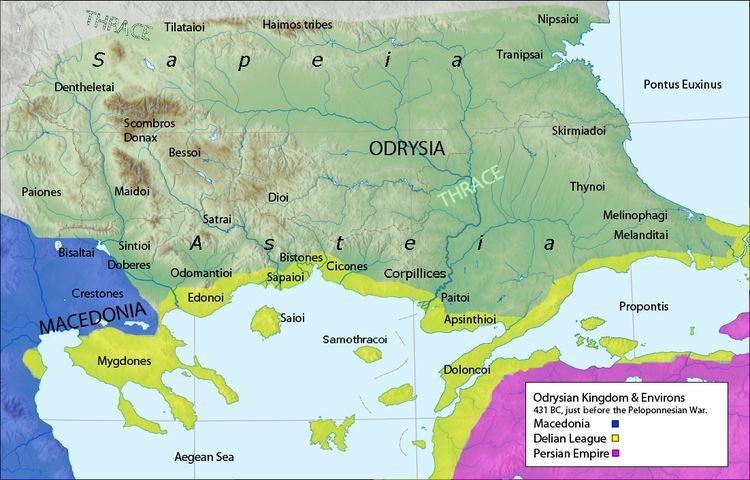 | ||
The Bessi (/ˈbɛsaɪ/; Ancient Greek: Βῆσσοι or Βέσσοι) were an independent Thracian tribe who lived in a territory ranging from Moesia to Mount Rhodope in southern Thrace, but are often mentioned as dwelling about Haemus, the mountain range that separates Moesia from Thrace and from Mount Rhodope to the northern part of Hebrus. Herodotus described them as a sort of priestly-caste among the Satrae, the Bessi being interpreters of the prophetic utterances given by a priestess in an oracular shrine of Dionysus located on a mountain-top.
Contents
In 72 BC, the proconsul of Macedonia Marcus Terentius Varro Lucullus defeated the Bessi in Thrace. Later Strabo, provides a record in which the Bessi are described as the fiercest of the independent Thracian tribes, dwelling on and around the Haemus range, and possessing the greater part of the area around that mountain chain. He calls them brigands among brigands and that they were addicted to plunder.
Mommsen says the capital of the Bessi was Uscudama now Edirne in modern Turkey but the real place seems to have been Bessapara, today Sinitovo near Pazardzhik, Bulgaria.
The Diobesi are thought to be a union of sorts between the Besai and the Dii. Pliny the Elder reveals that there were several divisions of the Bessi.
Appian writes that they fearfully surrendered to Augustus.
Towards the end of the 4th century, Nicetas the Bishop of Dacia brought the gospel to "those mountain wolves", the Bessi. Reportedly his mission was successful, and the worship of Dionysus and other Thracian gods was eventually replaced by Christianity.
A Thracian personal name Bessus (attested in Northern Montenegro along with other Thracian names such as Teres) is considered to have the same etymon as Bessi (Wilkes, 1982).
In the 11th century Strategikon text, Cecaumenos the Byzantine historian described the Vlachs from Thessaly (i.,e. the Aromanians of Great Wallachia) as being descendants of ancient Dacians and Bessi who invaded from the area on the Danube, supposedly seeking revenge for the defeat inflicted to their ancestors by Trajan during the Dacian Wars.
Bessian monks in the Sinai
In 570, Antoninus Placentius said that in the valleys of Mount Sinai there was a monastery in which the monks spoke Greek, Latin, Syriac, Egyptian and Bessian.
The origin of the monasteries is explained in a mediaeval hagiography written by Simeon Metaphrastes, in Vita Sancti Theodosii Coenobiarchae in which he wrote that Saint Theodosius founded on the shore of the Dead Sea a monastery with four churches, in each being spoken a different language, among which Bessan was found. The place where the monasteries were founded was called "Cutila", which may be a Thracian name.
Further fate
Further fate of Thracians is a matter of dispute. Some authors like Schramm derived the Albanians from the Christian Bessi, or Bessians, an early Thracian people who were pushed westwards into Albania, while mainstream of historians support Illyrian-Albanian continuity or a possible Thraco-Illyrian creole.
